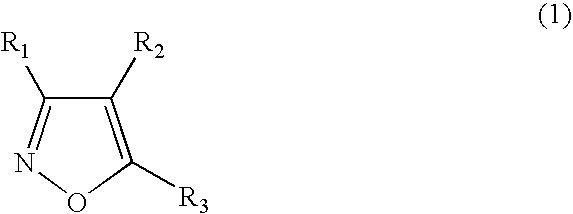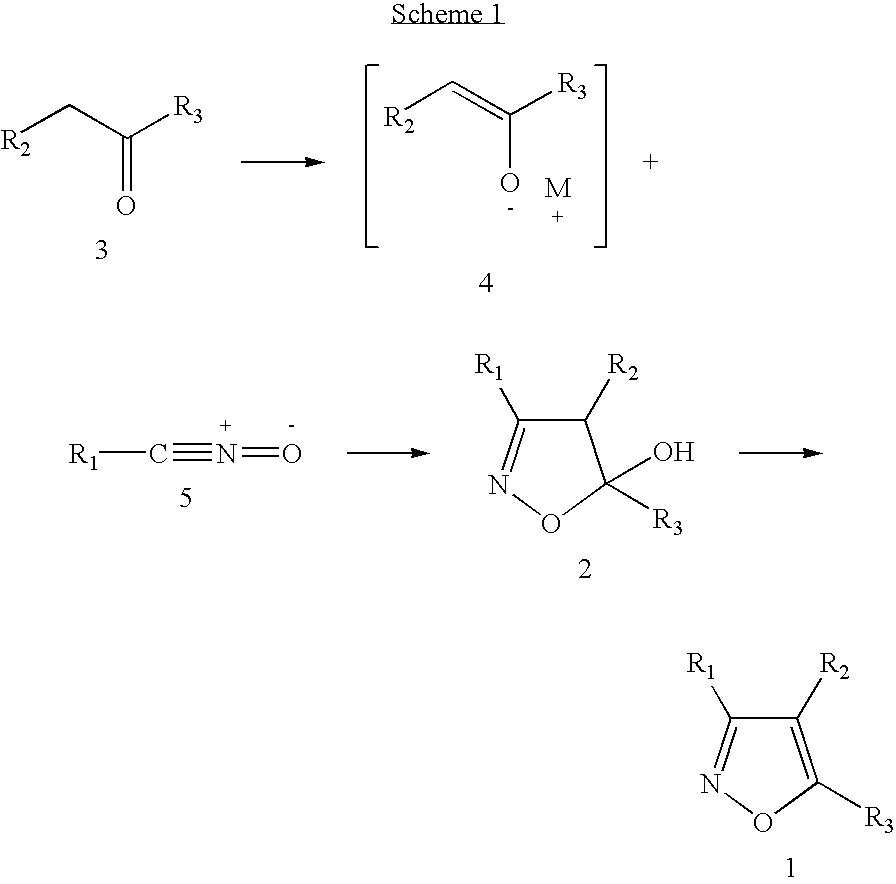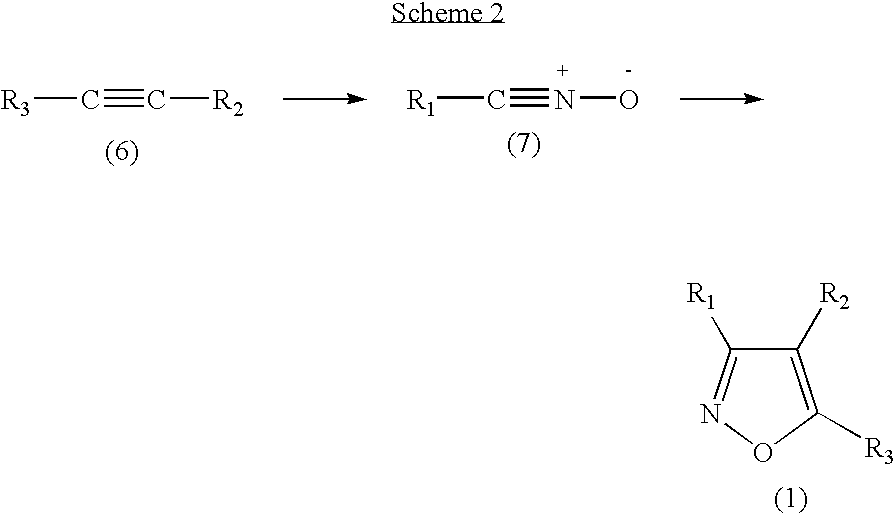Functionalized diarylisoxazoles inhibitors of ciclooxygenase
a technology of ciclooxygenase and diarylisoxazoles, which is applied in the direction of biocide, drug composition, cardiovascular disorder, etc., can solve the problems of high risk of myocardial infarction or death in patients with cardiovascular diseases, and achieve the effects of preventing diseases affecting the cardiovascular apparatus, preventing damage to the cardiovascular apparatus, and effective us
- Summary
- Abstract
- Description
- Claims
- Application Information
AI Technical Summary
Benefits of technology
Problems solved by technology
Method used
Image
Examples
example 1
[0068]
3-(Chlorofuran-2-yl)-4-phenyl-5-hydroxy-5-(trifluoromethyl)-2-isoxazoline
[0069]Reagents: 1,1,1-Trifluoro-3-phenyl-2-propanone and 2-(5-chlorofuryl)carbonitrile oxide. The product (71% yield) is isolated by chromatography (petroleum ether / ethyl acetate=15:1 until elution of the impurity with larger Rf and then 10:1). FT-IR (neat): 3600-3150, 3037, 2924, 2852, 1616, 1494, 1457, 1324, 1244, 1174, 1086, 1041, 1018, 946, 857, 790, 701 cm−1. 1H NMR (500 MHz, CDCl3, δ): 7.45-7.43 (m, 3H, aromatic protons, cis diastereoisomer); 7.34-7.32 (m, 3H, aromatic protons, trans diastereoisomer); 7.27-7.24 (m, 4H, two aromatic protons for each diastereoisomer); 6.44 (d, J=3.6 Hz, 1H, furyl proton, trans diastereoisomer); 6.23 (d, J=3.6 Hz, 1H, furyl proton, cis diastereoisomer); 6.16 (d, J=3.6 Hz, 1H, furyl proton, trans diastereoisomer); 6.13 (d, J=3.6 Hz, 1H, furyl proton, cis diastereoisomer); 4.92 (s, 1H, proton of the isoxazoline ring of the cis diastereoisomer); 4.79 (s, 1H, proton of the...
example 2
[0070]
3-(5-Chlorofuran-2-yl)-4-4-fluorophenyl)-5-hydroxy-5-methyl-2-isoxazoline
[0071]Reagents: 3-(4-fluorophenyl)-2-propanone and 2-(5-chlorofuryl)carbonitrile oxide. The product (62% yield) is isolated by chromatography (petroleum ether / ethyl acetate=7:3). M.p. 101-102° C. FT-IR (KBr): 3580-3100, 3050, 2999, 2926, 1602, 1512, 1495, 1442, 1392, 1374, 1318, 1233, 1126, 1014, 945, 917, 898, 828, 786 cm−1. 1H NMR (300 MHz, CDCl3, δ): 7.30-7.00 (m, 8H, four aromatic protons for each diastereoisomer); 6.47 (d, J=3.5 Hz, 1H, furyl proton, cis diastereoisomer); 6.15 (d, J=3.5 Hz, 1H, furyl proton, cis diastereoisomer); 6.12 (d, J=3.5 Hz, 1H, furyl proton, trans diastereoisomer); 6.09 (d, J=3.5 Hz, 1H, furyl proton, trans diastereoisomer); 4.40 (s, 1H, proton of the isoxazoline ring of the cis diastereoisomer); 4.36 (s, 1H, proton of the isoxazoline ring of the trans diastereoisomer); 1.75 (s, 3H, methyl of the trans diastereoisomer); 1.28 (s, 3H, methyl of the cis diastereoisomer). 13C NMR...
example 3
[0072]
3-(5-Chlorofuran-2-yl)-4-(2-fluorophenyl)-5-hydroxy-5-methyl-2-isoxazoline
[0073]Reagents: 3-(2-fluorophenyl)-2-propanone and 2-(5-chlorofuryl)carbonitrile oxide. The product (56% yield) is isolated by chromatography (petroleum ether / ethyl acetate=7:3). M.p. 130-131° C. (mixture of diastereoisomers). FT-IR (KBr): 3590-3200, 3131, 2964, 1613, 1582, 1547, 1490, 1458, 1387, 1378, 1229, 1206, 1145, 1100, 1015, 915, 901, 789, 758 cm−1. 1H NMR (300 MHz, CDCl3, δ): 7.40-6.90 (m, 8H, four aromatic protons for each diastereoisomer); 6.51 (d, J=3.6 Hz, 1H, furyl proton, cis diastereoisomer); 6.17 (d, J=3.6 Hz, 2H, one furyl proton of cis diastereoisomer and one of trans diastereoisomer); 6.12 (d, J=3.6 Hz, 1H, furyl proton, trans diastereoisomer); 4.84 (s, 2H, protons of the isoxazoline ring, 1 H for each diastereoisomer); 3.36 (bs, 1H, OH: exchange with D2O; proton of cis diastereoisomer); 3.15-2.80 (bs, 1H, OH: exchange with D2O, proton of trans diastereoisomer); 1.78 (s, 3H, CH3 trans...
PUM
| Property | Measurement | Unit |
|---|---|---|
| Temperature | aaaaa | aaaaa |
Abstract
Description
Claims
Application Information
 Login to View More
Login to View More - R&D
- Intellectual Property
- Life Sciences
- Materials
- Tech Scout
- Unparalleled Data Quality
- Higher Quality Content
- 60% Fewer Hallucinations
Browse by: Latest US Patents, China's latest patents, Technical Efficacy Thesaurus, Application Domain, Technology Topic, Popular Technical Reports.
© 2025 PatSnap. All rights reserved.Legal|Privacy policy|Modern Slavery Act Transparency Statement|Sitemap|About US| Contact US: help@patsnap.com



